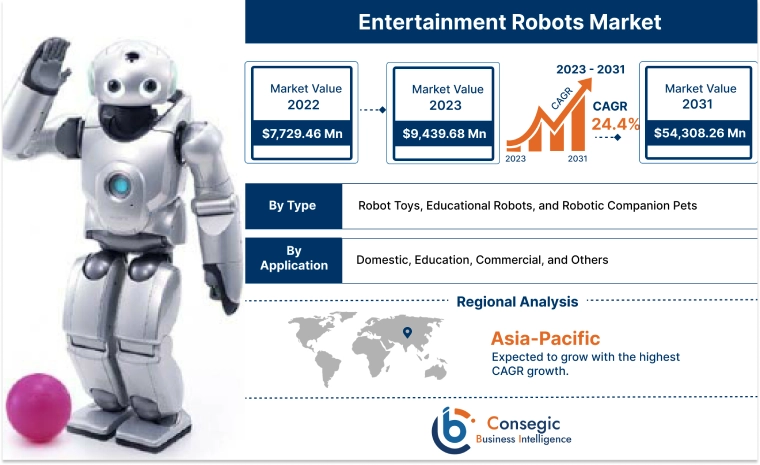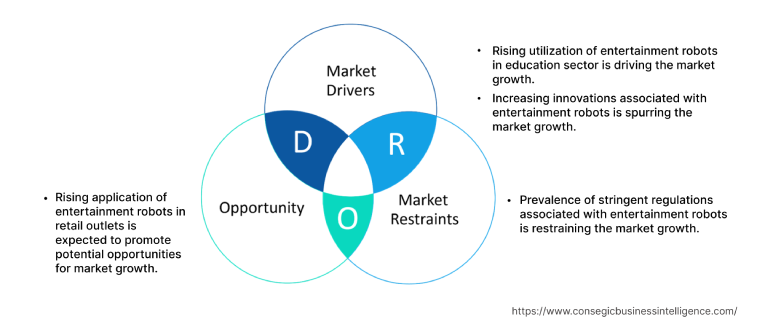Entertainment Robots Market Size :
Entertainment Robots Market size is estimated to reach over USD 65,903.48 Million by 2032 from a value of USD 11,520.01 Million in 2024 and is projected to grow by USD 14,121.02 Million in 2025, growing at a CAGR of 24.4% from 2025 to 2032.
Entertainment Robots Industry Scope & Overview:
Entertainment robots refer to a type of robot that is particularly designed to perform various tasks, including singing, playing games, dancing, and others, for the sole purpose of amusing or engaging human audiences. Moreover, they are capable of creating engaging and fun experiences for individuals of all ages and interests. Additionally, they are primarily used in multiple applications including domestic, education, commercial, and other related applications.
Entertainment Robots Market Insights :
Entertainment Robots Market Dynamics - (DRO) :
Key Drivers :
Rising utilization in the education sector is driving the market
Entertainment robots are often used in educational institutions to provide a fun and interactive approach to teaching. Additionally, they enable students of all ages to deepen their knowledge of programming and robotics, while learning other cognitive skills simultaneously. The aforementioned benefits are key determinants for increasing their utilization in the education sector.
For instance, according to the European Union analysis, approximately 93.3 million students enrolled across 6 education levels including pre-primary, primary, lower and upper secondary, post-secondary, non-tertiary, and tertiary levels across the European Union in 2020.
Therefore, analysis shows that the rising student enrolments in educational institutions are fostering the utilization of these robots for providing a fun and interactive approach to teaching, in turn driving the entertainment robots market growth.
Increasing innovations are spurring the entertainment robots market
Entertainment robot manufacturers are constantly investing in the development of new technologies and robots integrated with new features to ensure their efficient utilization in multiple applications including domestic, commercial, and educational applications among others. Hence, robot companies are launching new products with updated features and advancements.
For instance, in January 2023, WowWee Group Limited launched its new robot toy, MINTiD Dog-E. Dog-E is a robot dog integrated with touch sensors on its head, audio sensors for hearing sounds, and a persistence of vision (POV) tail that is capable of displaying messages and icons for communication.
Additionally, in October 2022, Hanson Robotics Limited partnered with Asia Entertainment Technology Limited to create, develop, and market a new line of merchandise which includes Sophia-themed apparel, posters, artwork, and collectibles. Sophia is a realistic humanoid robot that is designed for education, research, and entertainment purposes. Therefore, the increasing innovations associated with are proliferating the entertainment robots market growth and trends.
Key Restraints :
The prevalence of stringent regulations is restraining the market
The manufacturers of entertainment robots have to compulsorily comply with various stringent standards such as the International Organization for Standardization (ISO 13482), UL 3300, and others, which is a prime factor restricting the market growth.
For instance, ISO 13482:2014 specifies guidelines and demands for protective measures, safe design, and information for the utilization of robots and robotic devices. Additionally, the UL 3300 standard outlines the investigation for service, communication, information, education, and robots. UL 3300 specifies the requirements utilized for evaluating robot operational safety focusing on multidirectional mobility, external manipulation, user classes, fire and shock hazards, and use of surroundings to ensure the safe operation of robots in various environments with the presence of people.
Therefore, analysis portrays that the prevalence of the aforementioned standards is limiting entertainment robots market opportunities and trends.
Future Opportunities :
The rising application in retail outlets is expected to promote potential opportunities
Entertainment robots are often used in retail outlets such as shopping malls to amuse or engage customers and improve the customer's overall experience. Factors including rising investments in the expansion of retail outlets including shopping malls, and growing deployment of automation by retail enterprises are providing lucrative growth aspects for the global market trends.
For instance, in 2022, Arabian Centres invested around USD 1.6 billion in the development of two shopping malls in Jawharat Al-Riyadh and Jawharat Jeddah cities of Saudi Arabia, with the motive of offering modern experiences, integrating luxury retail brands, and a wide range of dining and entertainment offerings.
Therefore, analysis shows that the rising development of retail outlets is anticipated to increase the integration of robots in retail outlets for amusing or engaging customers and improving the customer's overall experience, in turn promoting entertainment robots market opportunities.
Entertainment Robots Market Report Insights :
| Report Attributes | Report Details |
| Study Timeline | 2019-2032 |
| Market Size in 2032 | USD 65,903.48 Million |
| CAGR (2025-2032) | 24.4% |
| By Type | Robot Toys, Educational Robots, and Robotic Companion Pets |
| By Application | Domestic, Education, Commercial, and Others |
| By Region | North America, Europe, Asia-Pacific, Latin America, and Middle East & Africa |
| Key Players | Sony Corporation, Hasbro, Mattel, KUKA AG, Modular Robotics Incorporated, Sphero Inc., Blue Frog Robotics, LEGO Group, Robobuilder Co. Ltd., Toyota Motor Corporation |
Entertainment Robots Market Segmental Analysis :
By Type :
Based on the type, the market is divided into robot toys, educational robots, and robotic companion pets. The robot toys segment accounted for the largest revenue share in 2024 of the total entertainment robots market share. Robot toys are particularly designed to imitate the behavior and movements of real beings, providing interactive and entertaining experiences for users of all ages. Moreover, robot toys offer a range of benefits including enhanced critical thinking, improved creativity and imagination, introduction to technology and engineering concepts, and others. Therefore report analysis shows that the above benefits of robot toys are further increasing their utilization in domestic and commercial applications among others.
For instance, Hasbro Inc. is among the manufacturers of robots that offer a broad range of robot toys in its product portfolio. Therefore, the rising advancements associated with robot toys are a prime factor proliferating the segment growth.
The educational robots segment is anticipated to register the fastest CAGR during the forecast period. They are designed to provide an interactive approach to teaching and enable children to develop one of the basic cognitive skills of mathematical thinking at an early age. Moreover, they enable students of all ages to deepen their knowledge of programming and robotics, while learning other cognitive skills simultaneously.
For instance, in April 2023, Elephant Robotics introduced its new desktop educational robots that are specifically designed to meet evolving educational demands. Thus, analysis shows that the increasing innovation associated with educational robots is a vital factor expected to drive the entertainment robots market trends.
By Application :
Based on the application, the market is segregated into domestic, education, commercial, and others. The domestic segment accounted for the largest revenue share in 2024 of the total entertainment robots market share. Factors including rising disposable income, advancements in artificial intelligence, and increasing popularity of robotic toys among children are among the key prospects driving their utilization in domestic applications.
For instance, Mattel offers a broad range of toy robots in its product portfolio specifically designed for domestic applications. The company's toy robots are optimized for use by children aged 4 years and above to facilitate engaging and imaginative play. Thus, analysis depicts that the rising development of these robots for domestic applications is driving the entertainment robots market demand.
The education segment is expected to witness the fastest CAGR during the forecast period. The growing education segment is attributed to several factors including the rising trend towards the adoption of higher education enrolments, international student mobility, and increasing government initiatives and funding for the development of educational institutes among others.
For instance, according to the India Brand Equity Foundation, the Indian Government has taken multiple initiatives such as the Foreign Educational Institutions Bill and National Accreditation Regulatory Authority Bill for Higher Education to promote the educational sector comprising schools and colleges in India. These robots are often used in educational institutions to facilitate a fun and interactive approach to teaching and learning. Thus, rising government initiatives to support the education sector are among the key factors anticipated to drive entertainment robots market trends during the forecasted period.
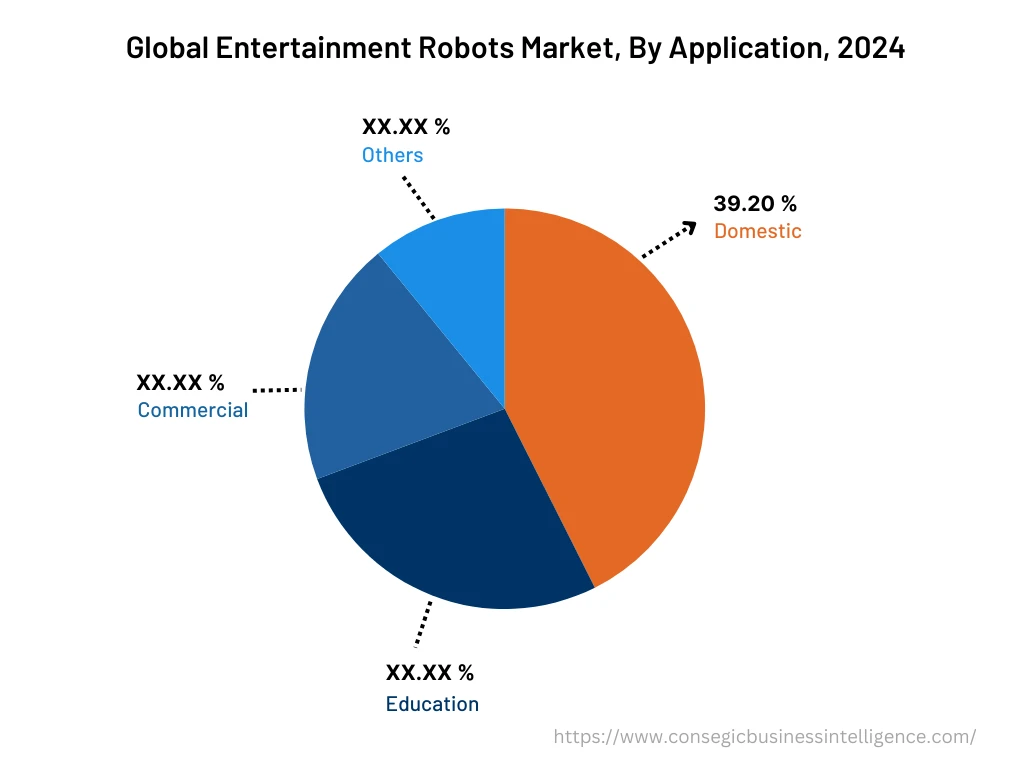
By Region :
The regional segment includes North America, Europe, Asia Pacific, the Middle East and Africa, and Latin America.
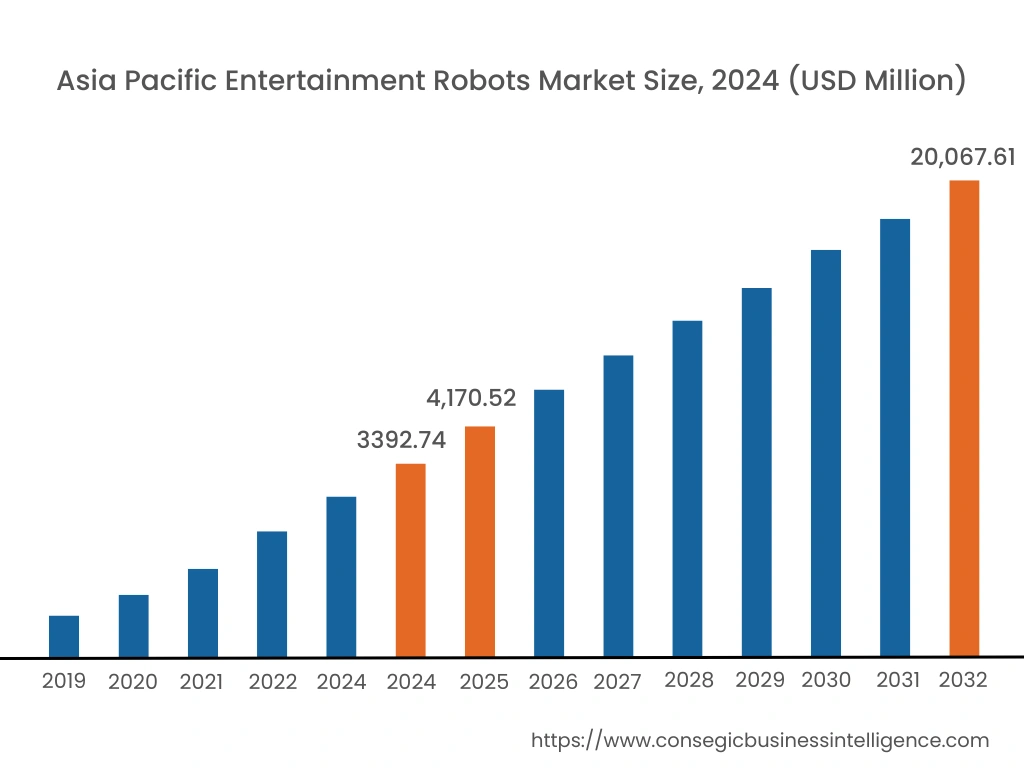
Asia-Pacific is expected to grow with the highest CAGR of 24.90% and is estimated to reach over USD 20,067.61 Million by 2032 from a value of USD 3,392.74 Million in 2024 and is projected to grow by USD 4,170.52 Million in 2025. In addition, in the region, China accounted for the maximum revenue share of 28.30% in the same year.
The growing pace of industrialization and development is creating lucrative development aspects for the market in the region. Moreover, the educational sector including schools, colleges, and others is contributing to the market growth for entertainment robots in the Asia-Pacific region. Additionally, the rising trend towards the adoption of higher education enrolments is further fueling the market in the region. Therefore, the growing education sector in the Asia-Pacific region is anticipated to drive their utilization to enable students to develop basic cognitive skills of mathematical thinking at an early age through play, thereby, proliferating the market growth in the region during the forecast period.
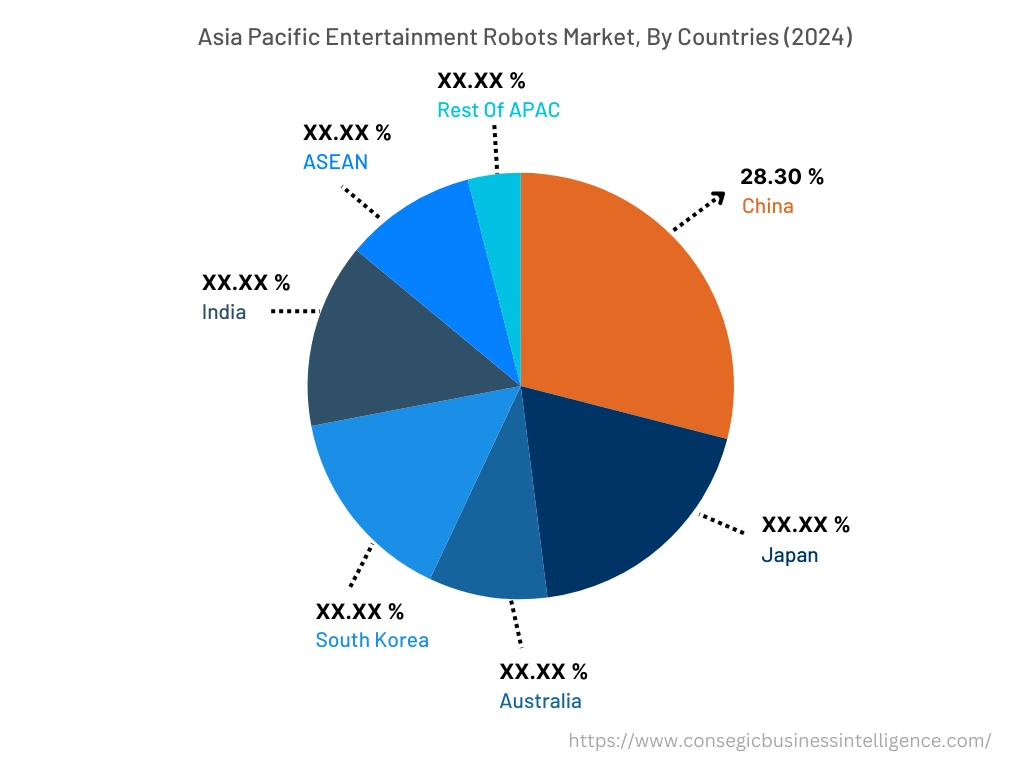
North America is estimated to reach over USD 21,359.32 Million by 2032 from a value of USD 3,821.28 Million in 2024 and is projected to grow by USD 4,675.11 Million in 2025.
As per the entertainment robots market analysis in the North American region is primarily driven by its deployment in education and commercial applications among others. Moreover, rising investment in educational institutions along with increasing demand for engaging and interactive learning approaches are among the significant factors driving the entertainment robots market demand in the region.
Additionally, factors including the prevalence of several robot manufacturers in North America such as Hasbro, Mattel, Modular Robotics Incorporated, Sphero Inc., and others lead to significant innovations in these robots in the North American region. The aforementioned factors are projected to drive market trends in North America during the forecast period.
Top Key Players & Market Share Insights:
The entertainment robots market is highly competitive with major players providing entertainment robots to the national and international markets. Key players are adopting several strategies in research and development (R&D), product innovation, and end-user launches to hold a strong position in the entertainment robots market. Key players in the entertainment robots industry include-
- Sony Corporation
- Hasbro
- LEGO Group
- Robobuilder Co. Ltd.
- Toyota Motor Corporation
- Mattel
- KUKA AG
- Modular Robotics Incorporated
- Sphero Inc.
- Blue Frog Robotics
Recent Industry Developments :
- In October 2023, Sony Corporation upgraded its system software for the AIBO series of robotic dogs. The upgrade enables AIBO to show richer behavior while it is at the charging station.
Key Questions Answered in the Report
What is entertainment robots? +
Entertainment robots refers to a type of robot that is particularly designed to perform various tasks, including singing, playing games, dancing, and others, for the sole purpose of amusing or engaging human audiences.
What specific segmentation details are covered in the entertainment robots report, and how is the dominating segment impacting the market growth? +
For instance, by type segment has witnessed robot toys as the dominating segment in the year 2024, owing to its increasing utilization in domestic and commercial applications among others.
What specific segmentation details are covered in the entertainment robots market report, and how is the fastest segment anticipated to impact the market growth? +
For instance, by end-user segment has witnessed education as the fastest-growing segment during the forecast period due to rising adoption of entertainment robots in educational institutions to facilitate interactive and engaging teaching/learning.
Which region/country is anticipated to witness the highest CAGR during the forecast period, 2025-2032? +
Asia-Pacific is anticipated to register fastest CAGR growth during the forecast period due to rapid pace of industrialization and growth of multiple industries such as including education, commercial, and others.
